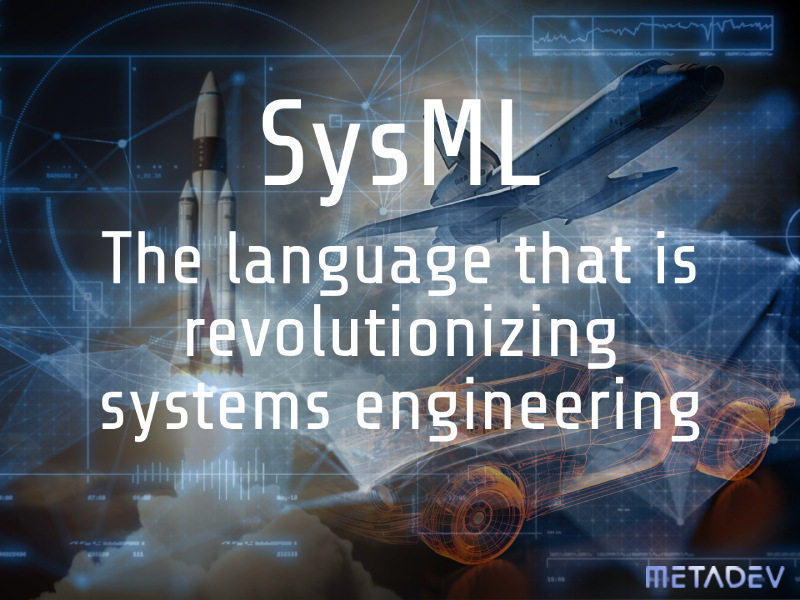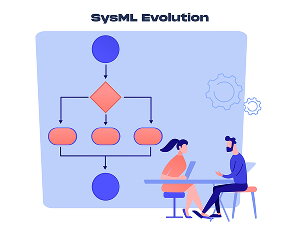SysML the language that is revolutionizing systems engineering
2025.02.27
Seville, Spain

Systems Modeling Language (SysML) is a standard widely used in systems engineering to represent, analyze and manage complex systems throughout their life cycle. SysML v2, the most recent evolution of this standard, offers greater expressiveness and enhanced capabilities compared to its predecessor, facilitating the accurate modeling of a system's requirements, structures, behaviors, and parameters. Its model-based approach allows for a clear and structured visual representation, helping to reduce errors, improve traceability and optimize decision making in highly complex projects.
One of the main benefits of SysML is its ability to integrate multiple disciplines, enabling software, mechanical, electronic, and systems engineers to collaborate efficiently. Thanks to its interoperability with other tools and standards such as UML, MBSE (Model-Based Systems Engineering), and simulation tools, SysML v2 has become a key tool for companies looking to improve consistency, communication, and complexity management in product and system development.
Industries using SysML
The use of SysML has expanded across multiple industrial sectors due to its ability to manage system complexity, enhance collaboration among interdisciplinary teams, and facilitate automation in model design and analysis.
Aerospace and Defense Industry
Systems Modeling Language (SysML) is widely used in the aerospace and defense industries to model and design complex systems such as aircraft, satellites, radar systems, weaponry, navigation, and flight control systems. Its ability to integrate multiple domains (mechanical, electronic, and software) facilitates the design and verification of critical systems, ensuring the coherent and safe operation of all components.
For example, Northrop Grumman has implemented SysML along with ModelCenter® MBSE to connect workflows to SysML models, allowing performance calculations, requirement verification, and design alternative analysis.
Additionally, the U.S. Department of Defense (DoD) has been actively involved in the transition from SysML v1 to SysML v2 to enhance the effectiveness and adoption of Model-Based Systems Engineering (MBSE). This transition aims to improve the accuracy, expressiveness, regularity, and interoperability of the language—crucial aspects for developing complex defense systems.
Meanwhile, Airbus has integrated MBSE, with SysML as its core, into its digital transformation efforts to manage the complexity of aerospace systems and reduce time to market. This approach supports Airbus’ commitment to developing zero-emission commercial aircraft by 2035.
Boeing has also advanced in adopting MBSE with SysML to optimize the integration and design of complex systems. Boeing uses SysML to process and manage large volumes of MBSE model data, improving requirements traceability and accelerating decision-making in aerospace projects. This digital approach helps manage the growing complexity of its systems and reduces development cycles, strengthening its competitiveness in a highly demanding global market.
Boeing’s participation in events such as INCOSE IS2024 reinforces its commitment to evolving MBSE practices and incorporating emerging standards such as SysML v2. This involvement in INCOSE highlights how Boeing, like other industry leaders, aims to establish a strong and common foundation for systems engineering that facilitates cross-disciplinary collaboration and ensures end-to-end traceability from requirements to implementation.
These examples demonstrate how SysML is essential for meeting the strict standards and certifications required in the aerospace and defense sectors, ensuring that systems are designed and operated safely and efficiently.
References
Automotive Industry
The automotive industry faces significant challenges due to the increasing complexity of modern vehicles, which integrate advanced hardware, electronic systems, and embedded software. In this context, SysML has established itself as a fundamental tool, enabling more efficient and robust development.
Some companies, such as Ford Motor Company, have used SysML to support the development of advanced driver assistance technologies.
SysML is a key tool in addressing the current challenges of the automotive industry, including the integration of advanced technologies, electrification, and intelligent connectivity. Its implementation not only optimizes the development process but also ensures that manufacturers can quickly adapt to market demands and comply with global safety and sustainability standards.
References
- SysML for embedded automotive Systems
- A MBSE Framework for the Design and Analysis of Complex Automotive Systems Using SysML and PCE
Energy Industry
Companies in the energy sector use SysML to model complex infrastructures such as smart grids, which integrate distributed generation, energy storage, and optimized consumption. SysML enables the modeling of these complex interactions, ensuring that components work harmoniously and efficiently. It also facilitates scenario planning, such as the integration of renewable energy sources, allowing companies to anticipate their impact on grid stability.
In critical infrastructures like nuclear power plants, SysML is used to model control, safety, and emergency response systems. It helps simulate failure scenarios, assess risks, and document regulatory requirements, ensuring compliance with strict safety standards.
SysML also supports the modeling of renewable energy generation and distribution systems, such as wind and solar farms, which require managing multiple variables (climatic variability, storage, grid integration). SysML allows for optimizing these systems, ensuring a balance between supply and demand.
It also assists in modeling electric power grids to evaluate performance and design predictive maintenance strategies.
The use of SysML in the energy industry enables the integration of technologies from different providers within a complex ecosystem, allows the modeling of interoperability standards, and ensures that all system components can communicate effectively. Additionally, it helps document processes and ensures compliance with international regulations.
References
- Ontology Development for SysML-Based Energy Harvester Design
- Analysis and Modeling of a Wind Power System based on SysML
- MBSE analysis for energy sustainability improvement in manufacturing industry
Railway Industry
The planning and design of high-speed trains, signaling systems, and railway traffic management require structured and validated modeling, making SysML an essential tool. Its implementation facilitates the optimization of critical processes, enhances safety, and ensures compliance with strict international standards to improve the security and efficiency of the sector.
Indra has implemented SysML-based modeling tools in the FR8RAIL II project. This initiative, part of the European Shift2Rail program, aims to digitalize and automate freight rail transport. Indra has used SysML to define the system architecture and ensure its integration with other systems developed within the project.
References
Healthcare and Medical Devices
In the development of medical devices and hospital systems, SysML facilitates the integration of software and hardware. This capability is essential to comply with strict regulatory standards, such as those established by the FDA and international norms like ISO 13485 and ISO 14971.
Modeling with SysML not only addresses the inherent complexity of biomedical systems but also enhances safety, reliability, and traceability throughout the product lifecycle.
Leading medical technology companies have adopted SysML to optimize their development processes. For example, Dassault Systèmes offers virtual twin solutions that enable medical device companies to simulate and refine products before physical production, accelerating innovation and ensuring regulatory compliance.
References
- Integrating Safety and Reliability Analysis into MBSE: overview of the new proposed OMG standard
- Cameo Safety and Reliability Analyzer
Telecommunications and Consumer Electronics
In the technology industry, SysML is used for designing network architectures, IoT devices, embedded systems, and consumer electronics products.
Its application enables companies to optimize connectivity and compatibility between different components, improving development efficiency, reducing costs, accelerating product validation and certification, and strengthening requirement traceability—essential aspects in highly regulated and competitive sectors.
References
Recommendations for using SysML
Although SysML (Systems Modeling Language) is not currently a mandatory standard, its adoption is steadily increasing due to the benefits it offers in terms of precision, expressiveness, and usability in complex system modeling. The evolution towards SysML v2 aims to further enhance these capabilities, potentially leading to broader adoption and eventual standardization in the future.
OMG is an international organization that develops technology standards, including SysML. Its support and promotion of SysML have been crucial to its utilization across various industries.
The push for SysML adoption in the industry is reflected in the work of leading companies that develop tools and solutions based on this language.
IBM has been one of the main advocates of SysML, particularly in the United States, where it is widely used in sectors such as automotive and aerospace.
Siemens, in collaboration with IBM, is developing next-generation model-based systems engineering solutions, leveraging the advanced capabilities of the open standard SysML v2. This collaboration aims to optimize design workflows and improve interoperability between engineering tools. Siemens' work highlights the potential of SysML v2 to redefine modern systems engineering.
The work of these companies reflects the industrial sector's commitment to the evolution and adoption of SysML, emphasizing its growing relevance in complex systems engineering and promoting process standardization.
In a world where technological innovation is key to competitiveness, SysML v2 serves as the bridge that connects disciplines, optimizes processes, and ensures that future systems are safer, more efficient, and sustainable. Its ability to adapt to the evolving needs of industries ensures that it will remain an essential standard in systems engineering for many years to come.
SysML v2 Implementation
SysML v2 implementation is becoming increasingly relevant for engineering teams seeking to update their workflows and tools in response to the growing complexity of modern systems.
Adopting SysML v2 means rethinking how system architecture is structured, communicated, and validated—enabling more coherent, modular, and traceable representations of complex systems.
As more and more teams take interest in SysML v2 implementation, we at metadev are committed to driving solutions that support this transformation. Our tool, Apricot, is a native SysML v2 environment built on web standards, designed with a focus on simplicity, real-time collaboration, and compatibility across a variety of work scenarios. Without shifting the main focus, Apricot enables users to explore SysML v2 implementation from a modern, accessible, and technically rigorous perspective.
This new phase in systems modeling opens the door to methodologies that are better aligned with the challenges of modern engineering. SysML v2 implementation is not just an incremental upgrade—it is an opportunity to rethink how we define, analyze, and share technical knowledge across multidisciplinary teams.
A version of Apricot is already available in private beta. We invite the developer community to stay tuned for the launch, participate in testing, and share their feedback. Try it
To further explore SysML and its applications, check out our related articles:
-
Introduction to modeling. Why is it essential and what can it offer you?

-
From the Origins of SysML to SysML v2 - The Evolution of the Systems Modeling Language

By reading these articles, you will gain a deeper understanding of how SysML is transforming modern engineering and why it is becoming an essential tool for designing complex systems.
Metadev. Simplyfing Complexity